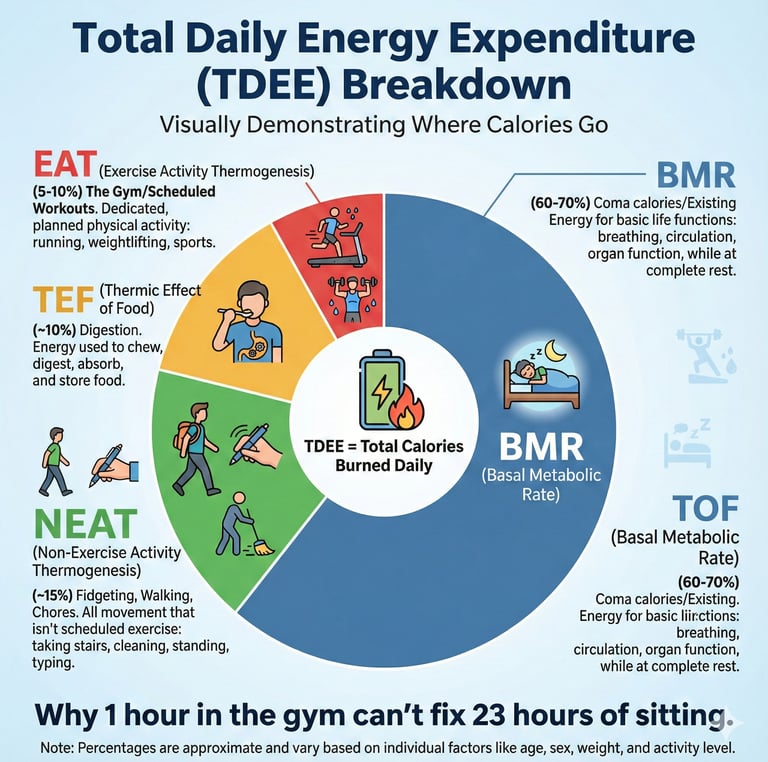Eating Less But Not Losing Weight? The Science of Why It Happens (And How to Fix It)
Eating less but not losing weight? Discover the 6 hidden reasons for your plateau, from metabolic adaptation to stress, and how to fix them today.
Loraine Berriman
12/1/20256 min read


You’ve swapped the morning bagel for a smoothie. You’ve said "no" to the office donuts. You’re technically eating less than you were a month ago.
Yet, every morning when you step on the scale, the number stares back at you unchanged. Or worse, it’s crept up.
This is one of the most frustrating places to be in a fitness journey. You feel like you’re suffering through hunger for zero reward. As a coach, I hear this story almost every week during consultation calls. Clients come to me convinced their metabolism is broken or that they’re simply destined to be this weight.
Here’s the reality. Your metabolism isn't broken. It’s just adapting.
According to research published by the National Institutes of Health (NIH), weight loss is rarely a linear process. "Eating less" is only one small piece of a much larger metabolic puzzle.
If you’re stuck in a calorie deficit but seeing no results, this guide explains exactly what’s happening inside your body and how to fix it without starving yourself.
The "Starvation Mode" Myth: Understanding Metabolic Adaptation
First, let’s address the elephant in the room. You might have heard that if you eat too little, your body enters "starvation mode" and holds onto fat.
This is a partial truth that often gets exaggerated. Your body doesn't stop burning fat entirely just because you skipped dinner. However, your body is incredibly smart. Its primary goal is survival.
When you drastically cut calories, your body senses a fuel shortage. To protect you, it becomes more efficient. It learns to do the same amount of daily work using less energy. This is called Metabolic Adaptation.
When you eat less, your body inadvertently down-regulates other energy-burning systems to keep you safe. It might slightly lower your body temperature or reduce your pulse. Most commonly, it makes you subconsciously move less throughout the day.
So while you are eating less, your body has matched your new low intake by burning less. You’re now in a caloric maintenance rather than a deficit.
Reason 1: The "Health Halo" and Hidden Calories
The most common reason for a weight loss plateau isn't a slow metabolism. It’s the "Health Halo" effect.
In my coaching practice, I often see clients switch to "clean eating" foods, such as avocados, olive oil, granola, and nut butters. While these are nutritious, they are incredibly calorie-dense.
Real World Example: I recently worked with a client in Plettenberg Bay who was "eating clean" but not losing weight. We audited her lunch. It was a healthy salad, but the olive oil dressing and handful of seeds added 600 calories. Her "light lunch" was nearly 900 calories.
The Fix: You don’t need to count calories forever. However, a 3-day audit is essential. For just three days, weigh and track everything. You might discover that your healthy snacks are closing your calorie gap.
Reason 2: The NEAT Factor (Why You Stopped Fidgeting)
This is the biggest secret in weight loss. There is a component of your metabolism called NEAT (Non-Exercise Activity Thermogenesis).
This covers all the calories you burn doing everything except sleeping, eating, or dedicated exercise. It includes walking to the car, fidgeting at your desk, standing while cooking, and playing with your kids.
When you start eating less, your brain sends a signal to conserve energy. You might subconsciously start sitting more. You take the elevator instead of the stairs. You stop tapping your foot.
Research by the Mayo Clinic suggests that NEAT can vary by up to 2,000 calories a day between individuals. If your diet has made you lethargic, your drop in daily movement might have completely erased your calorie deficit.
The Fix: Don't just rely on your hour in the gym. Aim for a "Step Target" as a non-negotiable daily habit. Aiming for 8,000 to 10,000 steps ensures your NEAT stays high, even when your calories are lower.
Reason 3: The Weekend Math Problem
I call this the "5-and-2 Dilemma."
Many of us are perfect soldiers from Monday morning to Friday afternoon. We eat in a 300-calorie deficit for five days. By Friday evening, we’ve "saved" 1,500 calories.
Then the weekend hits.
Friday night: Pizza and wine (+800 calories over maintenance).
Saturday: Brunch and a larger dinner (+1,000 calories over maintenance).
Sunday: A roast lunch and dessert (+500 calories over maintenance).
By Monday morning, you’ve eaten back the entire deficit you created during the week. You feel like you’re dieting because you’re strict 70% of the time. But the math averages out to zero weight loss.
The Fix: View your nutrition as a weekly budget, not a daily one. If you have a social event on Saturday, slightly reduce your calories on Wednesday and Thursday to "bank" them for the weekend.
Reason 4: Water Retention is Masking Your Fat Loss
This is vital for your mental sanity. Weight loss and fat loss are not the same thing.
You can lose fat but gain water weight at the same time. This makes the scale look stuck. This is especially common for women due to hormonal fluctuations.
Common triggers for water retention:
High Sodium: A salty meal can make you hold 1-2kg of water overnight.
Carbohydrates: Glycogen (stored carbs) binds with water. If you eat a pasta meal after a low-carb week, your muscles replenish their fuel stores. This pulls water with them.
Stress: High cortisol levels can lead to fluid retention.
If you’re eating well and moving, trust the process. The "whoosh" effect often happens after a few weeks, where the water drops suddenly, revealing the weight loss underneath.
Reason 5: You Are Losing Muscle, Not Fat
If your strategy is "eat as little as possible and do hours of cardio," you’re likely burning muscle tissue along with fat.
Muscle is metabolically expensive. It takes a lot of calories just to keep muscle on your body. If you lose muscle, your daily calorie burn (BMR) drops. This makes it harder to keep weight off long-term.
The Stewardship of Strength: From a Christian worldview, we can view strength training not as vanity, but as stewardship. We are caring for the vessel we’ve been given. We want to ensure it’s strong and capable for the years ahead. Prioritizing muscle means we’re building a body that can serve, move, and endure.
The Fix: Ensure you’re eating enough protein (roughly 1.6g to 2g per kg of body weight) to protect your lean mass. Combine this with resistance training at least twice a week.
6 Practical Fixes to Break Your Plateau
If you’re nodding along to any of the above, you don’t need to cut more calories. You need to edit your strategy. Here are the steps I use with my clients at The Fitness Edit.
1. The "Plate Method" Reset Stop obsessing over numbers. For lunch and dinner, fill half your plate with non-starchy vegetables. Fill a quarter with lean protein and a quarter with high-quality carbohydrates. Add a thumb-size of healthy fats.
2. Increase Your "Flux" Instead of eating less and moving less, try eating more and moving more. By fueling your body with slightly more food but increasing your daily activity, you rev up your metabolic rate.
3. Sleep is Your Secret Weapon If you sleep 5 hours a night, your hunger hormones spike. You are biologically wired to crave sugar when sleep-deprived. Treat sleep like an appointment.
4. Check Your Hormones If you’re truly doing everything right and the scale hasn't moved in 4 weeks, see your GP. Thyroid issues or insulin resistance can lower your metabolic rate.
If you’re tired of guessing and want a plan tailored to your metabolism, you don’t have to do it alone.
At The Fitness Edit, I specialize in helping busy clients navigate these exact plateaus. We look at the whole picture including nutrition, movement, stress, and sleep to build a roadmap that works for your life.
Click here to book a free discovery call and let’s get your progress moving again.
Reference List
NIH / PubMed Central - Detailed review on Adaptive Thermogenesis in humans and why weight loss plateaus occur
Mayo Clinic Proceedings - Dr. James Levine’s research on Non-Exercise Activity Thermogenesis (NEAT)
Journal of the International Society of Sports Nutrition - Protein recommendations for maintaining muscle mass during weight loss
Further reading on The Fitness Edit: '7 Healthy Eating Swaps for Sustainable Weight Loss.'
You can also read about 'Workout Plans for Weight Loss.'
Kickstart your fitness journey with our free 5-day 'unstuck' challenge. Stop the guesswork, boost your energy, and build healthy habits that fit your busy life.




The information provided in this blog post is intended solely for informational purposes. It is not meant to replace professional medical advice, diagnosis, or treatment. Consult health care providers for personalised medical advice and treatment options related to specific health concerns.
About The Author
Loraine is an International Personal Trainer certified through Trifocus Fitness Academy (South Africa). She believes fitness should be accessible to everyone, regardless of age or starting point, and focuses on creating programs that fit real lives, not the other way around.
© 2025 Elevate Wellness Co. Pty Ltd. All rights reserved


